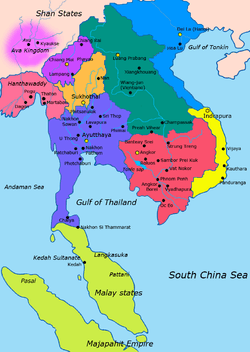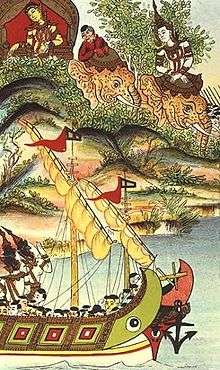Northern Khmer dialect
| Northern Khmer | |
|---|---|
| Surin Khmer | |
| ភាសាខ្មែរ | |
| Pronunciation | [psaː kʰmɛːr] |
| Native to | Thailand, Cambodia, USA, France, Australia |
| Ethnicity | Northern Khmer |
Native speakers | 1.4 million, very few monolingual[1] (2006)[2] |
|
Austroasiatic
| |
|
No standard form mostly oral, sometimes Thai script[3] | |
| Language codes | |
| ISO 639-3 |
kxm |
| Glottolog |
nort2684[4] |
Northern Khmer, also called Khmer Surin, is the dialect of the Khmer language spoken by approximately 1.4 million Khmer native to the Thai provinces of Surin, Sisaket, Buriram and Roi Et as well as those that have migrated from this region into Cambodia.[5]
Northern Khmer differs from the standard language, based on a dialect of Central Khmer, in the number and variety of vowel phonemes, consonantal distribution, lexicon, grammar, and, most notably, pronunciation of syllable-final /r/, giving Northern Khmer a distinct accent easily recognizable by speakers of other dialects. Some speakers of Northern Khmer may understand other varieties of Khmer but speakers of standard Khmer who have not been exposed to Northern Khmer often have trouble understanding Northern Khmer at first. The two varieties are 80–85% cognate on a basic 270-word list.[5] These facts have led some linguists to advocate considering Northern Khmer a separate, but closely related language.[6]
History

Teal: Lan Xang
Purple: Lanna
Orange: Sukhothai Kingdom
Blue Violet: Ayutthaya Kingdom
Red: Khmer Empire
Yellow: Champa
Blue: Dai Viet
After the fall of the Khmer Empire in the early 15th century the Dongrek Mountains served as a natural border, leaving the Khmer north of the mountains increasingly under the sphere of influence of Lan Xang. The conquests of Cambodia by Naresuan the Great for Ayutthaya furthered the political and economic isolation from Cambodia proper, leading to a dialect that developed relatively independently from the midpoint of the Middle Khmer period.[7]
Subsequently, the Isan area was claimed by the Lao Kingdom of Champasak in 1718 and in 1893, the region became part of the Kingdom of Siam (Thailand) as a result of the Franco-Siamese War. Throughout this period, the Northern Khmer people shared the rural mountainous highlands with the Lao, Thai and various Mon-Khmer groups such as the Kuy, leading to a high degree of multilingualism.[8] These varied influences and unique history have resulted in a distinct accent, with characteristics of the surrounding tonal languages, lexical differences through borrowing from Lao, Kuy and Thai, and phonemic differences in both vowels and distribution of consonants.
Phonology
Northern Khmer has the typical Mon-Khmer consonant and syllable structure although there is no phonemic phonation.[5] The primary divergences from Central Khmer phonology are in the realizations of some syllable-final consonants and in the vowel inventory.[5] Northern Khmer is also losing the sesquisyllabic pattern of its sister languages.[9] Many dysllables have lost all but the first consonant of the pre-syllable, creating a great number of consonant clusters. In many dialects of Northern Khmer, however, inserting a generic syllable, /-rɔ-/, after an initial consonant is still optional, returning some words to their original sesquisyllabic structure.[9]
Consonants
The consonant inventory of Northern Khmer is identical to that of Central Khmer. It is laid out below as reported by Thomas.[3]
| Labial | Dental/Alveolar | Palatal | Velar | Glottal | |
|---|---|---|---|---|---|
| Plosive | p, pʰ | t, tʰ | c, cʰ | k, kʰ | ʔ |
| Implosive | ɓ | ɗ | |||
| Nasal | m | n | ɲ | ŋ | |
| Liquid | ɲ l | ||||
| Fricative | s | h | |||
| Approximant | ʋ | j | |||
Syllable-initial consonants are pronounced as in Central Khmer. When appearing as a syllable-final, however, the /k/, /ʔ/ and ŋ that would be expected in Central Khmer are often realized as /c/, /k/ and /r/, respectively, in Northern Khmer. Additionally, as mentioned above, syllable-final /r/ which has become silent in all other dialects is markedly pronounced.[3]
| Khmer Script | English gloss | Central Khmer (IPA) | Northern Khmer (IPA) |
|---|---|---|---|
| ពាក្យ | word | /piəʔ/ | /piək/ |
| ភ្នែក | eye | /pnɛːk/ | /pnɛːc/ |
| ដឺង | know | /dəŋ / | /deɲ/ |
| ខ្មែរ | Khmer | /khmae/ | /khmɛːr/ |
Vowels
| Khmer language |
|---|
 |
| Khmer language |
| Dialects |
The biggest distinction between Northern Khmer of Thailand and Central Khmer of Cambodia is in the inventory of vowel phonemes. Smalley described 14 pure vowels that occur both long and short.[10]
| Front | Central | Back | ||
|---|---|---|---|---|
| unrounded | rounded | |||
| Close | /i/ | /ɨ/ | /u/ | |
| Near-close | /ɪ/ | /ʊ/ | ||
| Close-mid | /e/ | /ə/ | /ɤ/ | /o/ |
| Open-mid | /ɛ/ | /ʌ/ | /ɔ/ | |
| Open | /a/ | /ɑ/ | ||
Smalley also described three "vowels with offglides" that he treated as monophthongs, namely /iə/, /ɨə/ and /uə/, for a total of 17 vowel phonemes.[5] All 17 vowels may occur in closed syllables and all but ɨə have been found in open syllables. With 14 basic vowel positions, and having more back vowels than front, Northern Khmer is atypical. By contrast, standard Central Khmer only has 9 or 10 basic vowel positions, depending on the analysis.[11][12]
Script
Northern Khmer is, for the most part, a spoken language as most speakers are unable to read or write their native tongue[13] due to Thaification policies either enacted or supported by the Thai government. However, recent renewed interest and enthusiasm in Khmer language and culture has resulted in a two-fold increase in the use of Northern Khmer since 1958 and the consequential need for a formalized method of writing the language.[8] Since the Thai language is the medium of public education and, until the 21st century, the media, Khmer is taught at home or by monks in the local Khmer temples, often supported by Khmers in Cambodia or Western nations.[13][14]
In Thailand, Northern Khmer is written in the Thai script.[3] As many sounds occur in Northern Khmer that would be impossible to write according to the rules of Thai orthography, a few innovations are necessary such as using ฮ (initial /h/ in Thai) at the end of words to represent syllable-final /h/ and ญ (initial /ɪ/, final /n/ in Thai) to represent Northern Khmer's palatal nasal /ɲ/. Special diacritics are also sometimes used with the vowels because Northern Khmer has more vowel positions than Thai.[3]
Within Cambodia, Northern Khmer is written in the Khmer script as the words are spelled in standard Khmer, regardless of the Northern Khmer pronunciation. This is seen most often in the context of kantrum music karaoke DVDs which are increasingly popular in Cambodia and with Cambodians overseas.
References
- ↑ William J. Frawley, ed. (2003). International Encyclopedia of Linguistics. 1 (2nd ed.). Oxford University Press. p. 488.
- ↑ Northern Khmer at Ethnologue (18th ed., 2015)
- 1 2 3 4 5 Thomas, Dorothy; Popularizing the Northern Khmer Orthography: Sociolinguistics in Action Workshop in Northern Khmer Orthography, Surin; Mon-Khmer Studies Journal. 16–17: 255–265
- ↑ Hammarström, Harald; Forkel, Robert; Haspelmath, Martin; Bank, Sebastian, eds. (2016). "Northern Khmer". Glottolog 2.7. Jena: Max Planck Institute for the Science of Human History.
- 1 2 3 4 5 Thomas, David & Wanna, Tienmee; 1984; An Acoustic Study of Northern Khmer Vowels; Mon-Khmer Studies, vol 16–17
- ↑ Thomas, David. 1990. "On the 'language' status of Northern Khmer." JLC 9.1:98–106
- ↑ de Bernon, Olivier. "Khmer of Surin: Lexical Remarks". 1988.
- 1 2 Smalley, William A. (1988). Language Sciences. Volume 10, Issue 2, 1988. Multilingualism in the Northern Khmer population of Thailand. New Haven, CT. pp. 395–408. doi:10.1016/0388-0001(88)90023-X.
- 1 2 Phon-ngam, Prakorb; 1992; The Problem of Aspirates in Central Khmer and Northern Khmer
- ↑ Smalley, William A.; 1976; The Problem of Vowels: Northern Khmer; Canberra; Pacific Linguistics C-43; pp 25–42.
- ↑ Huffman, Franklin. 1970. Cambodian System of Writing and Beginning Reader. Yale University Press. ISBN 0-300-01314-0
- ↑ Wayland, Ratree. "An Acoustic Study of Battambang Khmer Vowels." The Mon-Khmer Studies Journal. 28. (1998): 43–62.
- 1 2 "Khmer Surin Get Support from US Group"; VoA; 23 December 2010
- ↑ Isara, Choosri; 2008; THE USE OF NORTHERN KHMER IN COMMUNITY RADIO PROGRAMS IN THAILAND; Mahidol University, Bangkok, Thailand
Further reading
- Thanan Čhanthrupant, and Chātchāi Phromčhakkarin. Photčhanānukrom Khamen (Surin)-Thai-Angkrit = Khmer (Surin)-Thai-English Dictionary. [Bangkok, Thailand]: Indigenous Languages of Thailand Research project, Chulalongkorn University Language Institute, 1978.
- Suwilai Prēmsīrat, and Sōphanā Sīčhampā. Kānphatthanā rabop kānkhīan Phāsā Khamēn Thin Thai Khrōngkān Phatthanā Phāsā Phư̄nbān phư̄a ʻAnurak Sinlapawatthanatham Phư̄nbān læ Phalit Sư̄ Tāng Tāng = Formulating Thai-based northern Khmer orthography : for the recording and preservation of local culture and for the producing of educational materials. [Bangkok]: Sathāban Wičhai Phāsā læ Watthanatham phư̄a Phatthanā Chonnabot, Mahāwitthayālai Mahidon, 1990. ISBN 9745868302
External links
- Thailand’s Khmer as 'Invisible Minority': Language, Ethnicity and Cultural Politics in North-Eastern Thailand
- The Cambodian Language in Thailand
- Description of Khmer: Lecture by Paul Sidwell of Australian National University